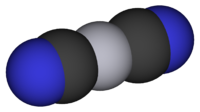- Mercury(II) cyanide
-
Mercury(II) cyanide 
 dicyanomercuryOther namesmercuric cyanide; cyanomercury; mercury cyanide; mercury dicyanide; hydrargyri cyanidum[1]
dicyanomercuryOther namesmercuric cyanide; cyanomercury; mercury cyanide; mercury dicyanide; hydrargyri cyanidum[1]Identifiers CAS number 592-04-1 PubChem 11591 Jmol-3D images Image 1 - C(#N)[Hg]C#N
Properties Molecular formula Hg(CN)2 Molar mass 252.63 g/mol Appearance white powder Density 3.996 g/cm3 Melting point 320°C[2]
Solubility in water 9.3 g/100 mL (14 °C)
53.9 g/100 mL (100 °C)[3]Solubility soluble in ethanol
slightly soluble in etherHazards NFPA 704  cyanide (verify) (what is:
cyanide (verify) (what is:  /
/ ?)
?)
Except where noted otherwise, data are given for materials in their standard state (at 25 °C, 100 kPa)Infobox references Mercury(II) cyanide, also known as mercuric cyanide, is a coordination compound of nitrogen, carbon and mercury. It is a colorless, odorless, toxic white powder with a bitter metallic taste.[1] It has a melting point of 320°C, at which it decomposes and releases toxic mercury fumes. It is highly soluble in polar solvents such as water, alcohol, and ammonia; slightly soluble in ether; and insoluble in benzene and other hydrophobic solvents.[2] It rapidly decomposes in acid to give off hydrogen cyanide. Samples also decompose when exposed to light, becoming darker in color.[4] It reacts vigorously with oxidizing agents; fusion with metal chlorates, perchlorates, nitrates, or nitrites can cause a violent explosion.[5]
Contents
Molecular and crystal structure
At ambient temperature and ambient pressure, Hg(CN)2 takes the form of tetragonal crystals.[2] These crystals are composed of nearly linear Hg(CN)2 molecules with a C-Hg-C bond angle of 175.0° and an Hg-C-N bond angle of 177.0° (Aylett[3] gives slightly different values of 189° and 175°, respectively). Raman spectra show that the molecules distort at higher pressures. Between 16-20 kbar, the structure undergoes a phase transition as the Hg(II) center changes from 2- to 4-coordinate as the CN groups bind to neighboring Hg centers forming via Hg-N bonds. The coordination geometry thus changes from tetragonal to tetrahedral, forming a cubic crystal structure, analogous to the structure of Cd(CN)2. Due to the ambidentate nature of the CN ligands, this tetrahedral structure is distorted, but the distortion lessens with increasing pressure until the structure becomes nearly perfectly tetrahedral at >40 kbar.[6]
As in the solid state, aqueous solution, Hg(CN)2 molecules are linear.[3]
Synthesis
Mercuric cyanide can be prepared by mixing yellow mercury oxide with hydrocyanic acid in the following chemical reaction.[3] This reaction is generally carried out by passing HCN gas into HgO in water. When soluble Hg(CN)2 is formed, the solution is evaporated to crystallize the product.[1]
- HgO + 2 HCN → Hg(CN)2 + H2O
Hg(CN)2 can also be prepared by mixing HgO, finely powdered Prussian blue[3][7] In addition, Hg(CN)2 can be produced by reacting mercuric sulfate with potassium ferrocyanide in water:[7]
- K4Fe(CN)6 + 3 HgSO4 → 3 Hg(CN)2 + 2 K2SO4 + FeSO4
Another method to generate mercuric cyanide is through the disproportionation of mercury(I) derivatives. In these reactions, metallic mercury precipitates, and Hg(CN)2 remains in solution:[7]
- Hg2(NO3)2 + 2 KCN → Hg + Hg(CN)2 + 2 KNO3
Reactions
Mercury cyanide can be used as a promoter in the Koenigs–Knorr reaction for the synthesis of glycosides.[2] Cyanogen, (CN)2, forms upon heating dry mercury cyanide but the method is inferior to other routes:[8]
- Hg(CN)2 → (CN)2 + Hg
Coordination polymers can be synthesized from Hg(CN)2 building blocks. Large single crystals of [(tmeda)Cu-[Hg(CN)2]2][HgCl4] form upon reacting the labile transition metal halide CuCl2, the soft Lewis acid Hg(CN)2, and N,N,N',N'-tetramethylethylenediamine (TMEDA). The migration of two labile chloride ligands from harder Cu(II) to softer Hg(II) drives the formation of the crystal.[9]
Past applications
Mercuric cyanide was once used as an antiseptic, but this practice has been discontinued due to its toxicity.[10] One example of this was the treatment of syphilis: a solution of 5-10 grains in an ounce of water, painted on with a camel-hair brush, was applied to syphilitic sores of the tongue or mouth.[citation needed] Hg(CN)2 is also used in photography.[11] It is still used in homeopathy under the Latin name Hydrargyrum bicyanatum.
Toxicology
Mercury(II) cyanide is one of the most toxic poisons. Its high toxicity is due to mercury and its two cyanide groups.
References
- ^ a b c "Hydrargyrum. Mercury. Part 5." http://chestofbooks.com/health/materia-medica-drugs/Manual-Pharmacology/Hydrargyrum-Mercury-Part-5.html (accessed April 1, 2009).
- ^ a b c d Kocovsky, P., G. Wang, and V. Sharma. "Mercury(II) Cyanide." e-EROS Encyclopedia of Reagents for Organic Synthesis. Chichester, UK: John Wiley & Sons, Ltd., 2001. http://www.mrw.interscience.wiley.com/eros/articles/rm034/sect0-fs.html (accessed April 1, 2009).
- ^ a b c d e Aylett, B.J. “Mercury (II) Pseudohalides: Cyanide, Thiocyanate, Selenocyanate, Azide, Fulminate.” Comprehensive Inorganic Chemistry 3:304-306. J.C. Bailar, Harry Julius Emeléus, Sir Ronald Nyholm, and A.F. Trotman-Dickenson, ed. Oxford: Pergamon Press, 1973; distributed by Compendium Publishers (Elmsford, NY), p. 304.
- ^ Brunton, L.T. A Text-Book Of Pharmacology, Therapeutics And Materia Medica. London: MacMillan & Co., 1885.
- ^ NOAA, Office of Response and Restoration, CAMEO Chemicals. "Chemical Datasheet: Mercuric Cyanide." NOAA. http://cameochemicals.noaa.gov/chemical/3829 (accessed April 2, 2009).
- ^ Wong, P.T.T. J. Chem. Phys. 1984, 80(12), 5937-41.
- ^ a b c Miller, W.L. Elements of Chemistry: Organic chemistry, 5th ed. New York: John Wiley & Sons, 1880, p. 100.
- ^ Brotherton, T.K.; Lynn, J.W. Chemical Reviews 1959, 59(5), 841-883, 844-846.
- ^ Draper, N.D. Chemistry of Materials 2003, 15(8), 1612–1616.
- ^ Benaissa, M.L.; Hantson, P.; Bismuth, C.; Baud, F.J. Intensive Care Med. 1995, 21(12), 1051-1053.
- ^ "Cyanides, Cyanide Oxides and Complex Cyanides." http://www.dncustoms.gov.vn/web_eglish/bieu_thue/E_HTM/E2837.HTM (accessed April 30, 2009).
External links
- National Pollutant Inventory: Cyanide compounds fact sheet
- National Pollutant Inventory: Mercury and compounds fact sheet
Mercury compounds Categories:- Mercury compounds
- Cyanides
Wikimedia Foundation. 2010.

